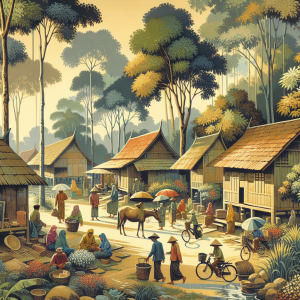The concept of home has always been central to the Singaporean Dream, symbolizing stability, security, and the promise of a brighter future. In a nation where the majority of residents live in public housing, the relationship between love, housing, and aspirations is particularly poignant. The recent shifts in the housing market, influenced by the COVID-19 pandemic, have not only reshaped consumer preferences but also impacted how relationships are formed and nurtured in Singapore.
The pandemic has catalyzed significant changes in housing preferences among Singaporeans. With many adapting to work-from-home arrangements, there has been a marked increase in demand for larger living spaces and homes situated on higher floors. This shift reflects a desire for environments conducive to both work and leisure, where couples can create a harmonious balance between professional responsibilities and personal lives. As a result, properties featuring additional rooms and elevated views have seen transaction prices rise significantly—by approximately $35.13 per square meter for higher-floor units and $18.10 per square meter for those with more rooms. This trend underscores how housing is not just a financial investment; it is also a critical factor in fostering relationships.
Moreover, the pandemic has diminished the desirability of locations near public transportation and central business districts. With commuting becoming less of a priority, couples are increasingly looking for homes that offer spaciousness and serenity over proximity to work. This change reflects a broader shift in values, where the quality of life and the ability to enjoy one’s home environment have become paramount. The evolving preferences signal a transformation in how Singaporeans view their living spaces—not merely as places to reside, but as sanctuaries for building and nurturing relationships.
The Role of Technology in Housing Decisions
The integration of Property Technology (PropTech) and big data analytics has revolutionized how Singaporeans approach their housing needs. Online platforms like PropertyGuru are now essential tools for prospective homeowners, providing real-time insights into market trends and consumer preferences. Keyword analysis from these platforms reveals a surge in interest in terms like "spaciousness" and "views," aligning closely with the rising prices of properties that embody these features. This indicates that the digital landscape is not just a marketplace but also a reflection of changing societal values and aspirations.
Implications for Future Relationships
As the housing market continues to evolve, the implications for relationships in Singapore are profound. The quest for a home that meets both partners’ needs can serve as a foundational element in a relationship, fostering communication and collaboration. Couples are increasingly viewing their housing choices as a joint venture, where decisions about space and location reflect shared values and future aspirations. This collaborative approach can strengthen bonds, as partners navigate the complexities of the housing market together.
Conclusion
In conclusion, the interplay between love, housing, and the Singaporean Dream is more intricate than ever. As the housing market adapts to new consumer preferences shaped by the pandemic, it also influences how relationships are formed and maintained. The desire for larger, more comfortable living spaces underscores a shift in priorities, emphasizing quality of life over mere convenience. As Singaporeans continue to navigate these changes, the home will remain a pivotal element in their personal journeys, shaping not just where they live, but how they love.





